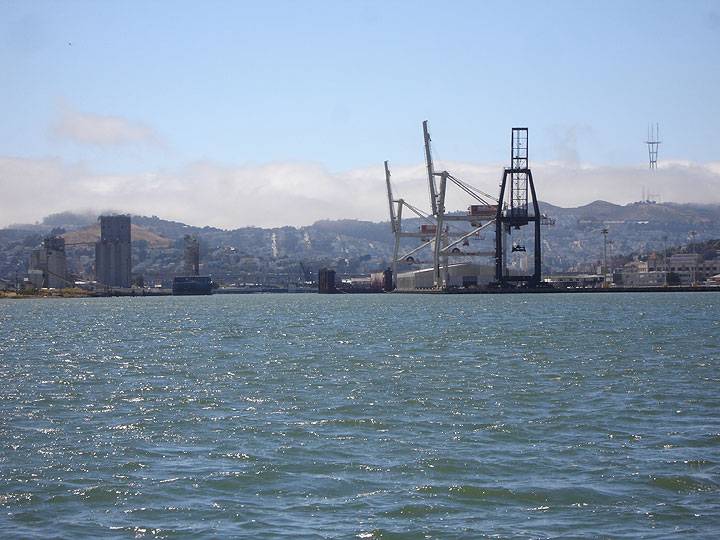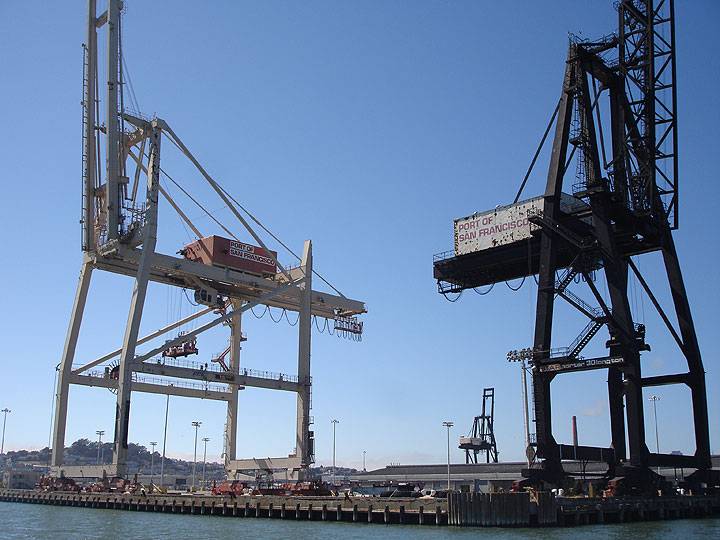New Facilities on Southern Waterfront 1967-1972
Historical Essay
by Chris Carlsson
Pier 80 at Islais Creek, part of the original Army Street Terminal.
Photo: Chris Carlsson
Today’s San Francisco waterfront is not a working port as it was during the first 100 years of the City’s life. The common understanding of why is that containerization, the new shipping technology based on multi-ton metal boxes that came in like gangbusters in the early 1970s, rendered San Francisco uncompetitive due to its older facilities and lack of inland space to store and move containers. This is certainly part of the story. But when The Port of San Francisco faced the containerization revolution in the late 1960s it did try to meet the challenge by making a big effort at modernization, albeit too late, and by making the wrong technological choices. In 1967 it opened the brand new Army Street Terminal, a state-of-the-art “break bulk” shipping facility, precisely at the time when containerization was overwhelming the old systems of “break bulk” cargo (meaning it was loaded and unloaded from ships without being inside large metal boxes).
Container cranes at Army Street Terminal
Photo: Chris Carlsson
After the opening of the Army Street Terminal it quickly became obvious that a container pier was needed. With the guidance of an consultant's report, the Port of San Francisco moved to build a new facility a bit further south, across Islais Creek at the edge of India Basin. Pier 98 was opened in 1972, but they did not build a container pier, not fully trusting that the technology of shipping had been settled. A competing technology known as LASH, for “lighter aboard ship,” based on the assumption that there would be some deep-draw ships that could not reach shallower ports, or that some ports would have limited facilities for offloading cargo. The 'lighter' would be floated by tug from ship to shore loaded with cargo. The Port had a tenant lined up for its new LASH terminal too, Pacific Far East Lines, which had committed to this new technology. Unfortunately PFEL went out of business after being acquired by a larger company headed by John Alioto (son of former Mayor Joe Alioto), who was unable to save the shipper from its mountain of debts and failed technology choice. When PFEL went bankrupt in 1978, the Port of San Francisco was left with a modern pier built to serve a specific shipping technology that no one was using. Though they converted Pier 80 and 98 to then-modern container-handling cranes by the late 1970s, the piers have remained largely unused over the past decades.
Instead of having built new container terminals in the late 1960s and early 1970s, the Port of San Francisco had built modern facilities with the assumption that other kinds of shipping would still be prevalent, a fatal error for the Port’s maritime future. (The strategic approach taken by the Port was further complicated by its being owned by the State of California and managed by the Board of State Harbor Commissioners [BSHC] until the City regained ownership in 1969.) By the early 1980s the Port of Oakland had taken nearly all of San Francisco’s business. Thanks to ongoing modernizations and expansions in Oakland since that time, San Francisco’s former thriving port is now a memory, with no chance of regaining its once prominent role in international trade.


